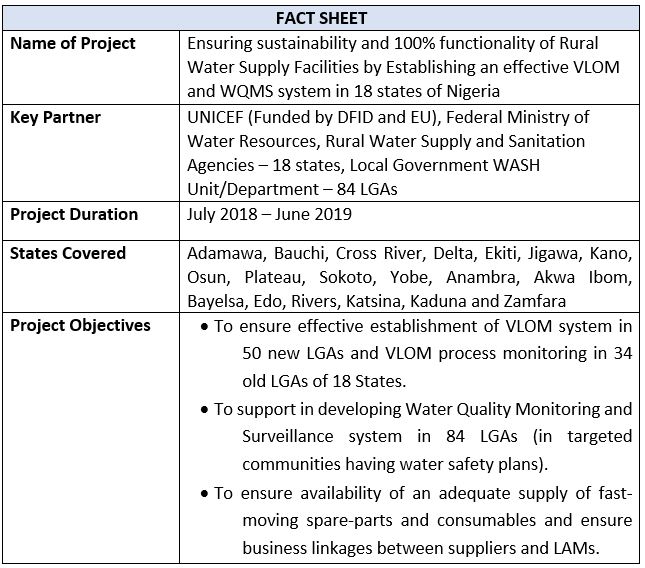The Challenge
With a population of over 200 million, Nigeria is the largest country in Africa. It also has one of the fastest growing economies in West Africa. Its gross GDP quadrupled between 2005 and 2015. However, this rapid economic growth has not translated into rapid poverty reduction and thus the nation has been falling behind in the accumulation of physical and human capital, with poor access to Water Sanitation and Hygiene (WASH) services being a key factor (Molini et al. 2016). The country did not achieve the Millennium Development Goals (MDGs) for water and sanitation. Only 61% of the citizens have access to improved water.
CURRENT CHALLENGE
Furthermore, only 41% of the population has access to improved water within 30 minute round-trip of their premises and only 31% have access to improved water on premises. Even fewer, 7 percent, possess piped water on premises. Analysis conducted by as part of the Nigeria WASH Poverty Diagnostic by the World Bank almost half of the existing water points and schemes in Nigeria are non-functional. Almost 30% of the water points and water schemes fail within their first year of operation. This multidimensional failure has not only fueled mounting water stress in the country but also has created poverty trap by adversely affecting poverty and human development outcomes. There are usually multiple sources of water in most villages. Of the total existing sources, a large percentage are not functioning due to various reasons such as mechanical faults, electricity failures, pipe bursts, vandalism by miscreants and unskilled persons, lack of community ownership, etc. In absence of quantitative and qualitative data on water sources and their usages by rural communities, plans do not achieve desired goals many times. Findings from the National Hand pump Functionality survey carried out by UNICEF-TCF indicate 56.22% of hand pumps are functional. Survey was conducted between August 2010 and January 2011 in 12 States – 2 States from each of 6 geo-political zones of the country. There is a strong need to make the remaining water facilities functional so that the communities can get safe and clean drinking water close to their houses. Water quality as a major public health issue and its relations to the economic well-being is elaborately articulated in the Sustainable Development Goal (SDG) 6. Polluted water has an implication for many life-threatening diseases such as Diarrhea, Dysentery, Gastroenteritis, Typhoid fever, Cholera, Hepatitis, Schistosomiasis, Guinea worm etc. These diseases are collectively known as water-related diseases. Asides microbial pollution, chemicals such as nitrate, nitrite, arsenic, fluoride, lead, cadmium, chromium, manganese, mercury and aluminum above permissible limits present serious health challenges to the populace, especially the children and immune compromised individuals. The contribution of iron and manganese to colored water and its psychological effect on consumers that could perhaps lead to rejection of seemingly safe water cannot be ignored. Drinking water management, though seemingly simple is somewhat complex as it involves three different stages namely; source, transport and point of use (water chain).
Our Approach
Tulsi Chanrai Foundation – Mission for Water Programme is focused on the concept of establishing Village Level Operation Maintenance (VLOM), and Water Quality Monitoring & Surveillance system of Drinking Water facilities across Nigeria.
The key components of VLOM strategy is formation of Water Sanitation and Hygiene (WASH), Capacity Building of WASHCOMs on Preventive Maintenance, Water Quality Monitoring & Management of Water Sources, Identification and training of Local Area Mechanics, Creating and establishing linkages for Local Supply Chain mechanisms for spare parts, Advocacy and Linkages with Rural Water and Sanitation Agency (RUWASSA) and Local Governments.
Maximizing the utilization of Government infrastructure thus saving unnecessary duplication and expense.
Our Programs
- Support in the establishment of an effective Village Level Operation and Maintenance (VLOM) and Water Quality Monitoring and Surveillance (WQMS) system in the targeted communities and LGAs.
- Ensure availability of an adequate supply of fast-moving spare-parts and consumables and ensure business linkages between suppliers and Local Area Mechanics.
- Ensure community participation and facilitating gender mainstreaming in Planning, Implementation and Operation & Maintenance of water facilities.
- Enhance the capacities and technical skills of Local Area Mechanics and village level caretakers to implement, manage, and sustain the community-based water supply schemes.
Current Programs
Previous Programs

The Impact
Photo Gallery
Case Studies



























